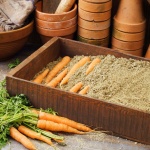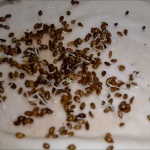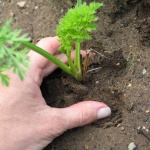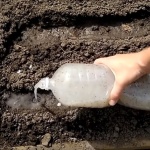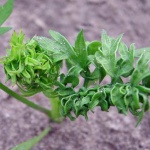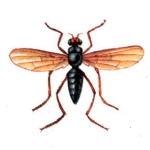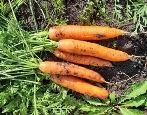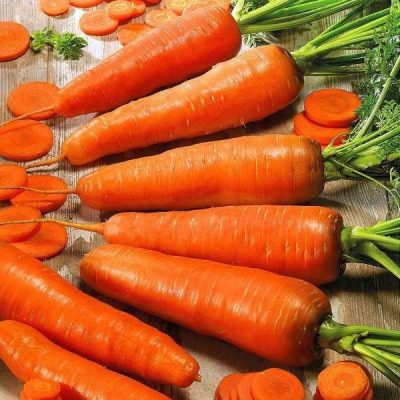
- Name synonyms: Flaker
- Appointment: for fresh consumption, for canning, for freezing, for bundled products, for making juice
- Weight, g: 170-200
- The form : conical
- Ripening terms: late ripening
- The size : long
- Length, cm: 25-28
- Bark coloration: red-orange
- Core color: red-orange
- Core size: small
Flakke carrots are a fairly common variety, the advantages of which include high yields and excellent fruit taste. It is worth considering in more detail the properties of the vegetable and the methods of its cultivation.
Description of the variety
Flakke is a variety whose fruits are well stored in winter and do not lose their taste and useful properties. The positive characteristics of carrots include large green leaves collected in the tops, which makes it easy to harvest.
Characteristics of the appearance of the plant and root crops
The variety forms rather large root crops, among the characteristics of which it is worth noting the following:
- shape - cone rounded towards the end;
- weight - from 170 to 200 g;
- red-orange smooth skin with faint eyes;
- lateral shoots are absent.
The variety itself is quite compact, which makes it possible to grow it in small garden plots.
Purpose and taste of tubers
The pulp of carrots has a rich orange hue, which can be achieved thanks to the unique nutrients contained in the composition. One hundred grams of carrots contain:
- carotene - 19 mg;
- fructose - 11 mg;
- vitamins and minerals.
The core of the fruit is quite pronounced. Carrots are used in the preparation of soups, salads, main courses. Also, the vegetable is rubbed for subsequent freezing or conservation. The dense skin provides the ability to transport root crops over long distances.
Maturation
On average, Flakke carrots form fruits in 140 days from the moment the culture is planted in open ground. If necessary, as well as in the southern regions, the ripening period can be reduced.
Yield
The indicator reaches 9-10 kg per square meter. Compliance with agrotechnical recommendations will increase the yield of carrots to the maximum.
Growing and care
Planting Flakke carrots does not cause any difficulties if you determine in advance the time of work and prepare the soil and seed. To achieve maximum yield, it is necessary to observe the planting scheme - 20x4 cm.
Before planting, the soil should be thoroughly fertilized with organic compounds and loosened to saturate it with oxygen and evenly distribute the fertilizing. When the first shoots sprout, you should take care of the young plant. Agrotechnical recommendations will be as follows.
- Watering. Moisture should be applied to the soil once a week. In this case, the land must be watered so that it is saturated with water by at least 15 cm. It is better to water the carrots at dawn or in the evening so that the sun does not burn the plant.
- Loosening. An obligatory procedure that should be performed after each watering. Loosening is often accompanied by weeding, preventing the spread of diseases and pests by weeds.
- Top dressing. Fertilize carrots often, about every 2 weeks from the moment of planting. At the same time, gardeners are advised to use organic and mineral complexes to give the plant everything it needs to form large root crops.
It is better to pick carrots at a temperature of 12 to 14 degrees Celsius. Storage is carried out in cool rooms with low humidity.
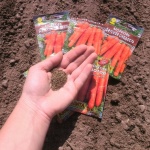
Carrots are one of the most unpretentious crops in terms of growing conditions; they can endure a short drought and a short cold snap.However, to get tasty and large root crops, you should adhere to the basic rules for planting carrots.
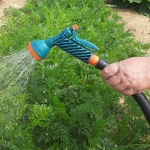

Soil requirements
Flakke is quite demanding on the type and composition of the soil. Recommendations for choosing a location:
- preference should be given to sunny areas where there are no drafts;
- the soil should be fertile and loosened, sandy loam or loamy;
- the soil acidity indicator should be neutral.
The last point can be provided on your own using special fertilizers.
Required climatic conditions
Flakke carrots are planted in spring, from March to May. It is important that warm weather is established outside with temperatures above 15-20 degrees and the risk of frost return is minimal. Before planting, the soil should warm up to 10 degrees.
Disease and pest resistance
Flakke is able to boast of strong immunity. But non-observance of agrotechnical recommendations can lead to the development of diseases and attacks of pests. To reduce the risk of culture damage, preventive treatments should be carried out, as well as:
- disinfect the seed before planting by soaking it in a solution of potassium permanganate;
- choose the right site, carefully approaching the study of soil properties;
- process fruits and tops when the first signs of the disease are detected.
Also, gardeners recommend carrying out preventive treatment by spraying the culture with weakly concentrated compositions.

Carrots grow in almost any garden. There is an opinion that this culture is very resistant to all kinds of diseases and pests, but this is not the case. Without proper care, carrots become susceptible to all kinds of infections and are affected by harmful insects.
Review overview
Gardeners speak positively of Flakke carrots, as they are attracted by the rapid survival of seeds and resistance to most common diseases. To get a high yield, it is recommended to follow the planting scheme and follow agrotechnical care instructions.

